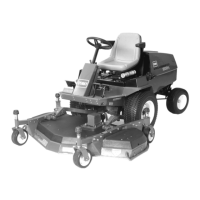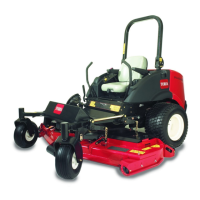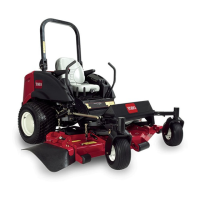24
4. Lubricate the traction pedal bushings and steering shaft
with a few drops of SAE 10W-30 oil or dry spray lube
(Fig. 21).
m–5131
Figure 21
Brake Service
Always set the parking brake when you stop the machine or
leave it unattended. If the parking brake does not hold
securely, an adjustment is required.
Checking the Brake
1. Park the machine on a level surface, disengage the
power take off (PTO), set the parking brake, stop the
engine, and remove the key.
2. The drive wheels must lock when the brake is applied.
An adjustment is required if the wheels turn and do not
lock; refer to Adjusting the Brake, page 24.
3. Release the brake. The wheels should rotate freely.
4. If both conditions are met no adjustment is required.
Important With the parking brake released, the drive
wheels must rotate freely. If brake action and free wheel
rotation cannot be achieved, contact your service dealer
immediately.
Adjusting the Brake
If the drive wheels do not rotate freely when the brake lever
is in the OFF position, or the brake does not hold when the
lever is in the ON position, an adjustment is required.
1. Move the brake lever to the ON position.
2. Measure the distance between the disc brake actuating
arm and stop pin on the axle bracket assembly (Fig. 22).
The distance should be less than 1/4 in. (6 mm).
3. If the distance is greater than 1/4 in. (6 mm), tighten the
locknut to decrease the distance between the actuating
arm and stop pin (Fig. 22).
4. With the brake lever OFF, check the clearance between
the brake pads and disc with a feeler gauge (Fig. 22).
Proper clearance is approximately 0.01 in. (.25 mm).
5. The actuating arm should be no more than 3/8 in.
(10 mm) away from the stop with the brake lever in the
ON position.
6. Check the brake operation again; refer to Checking the
Brake, page 24.
7. Check the adjustment. The drive wheels should rotate
freely when the brake lever is in the OFF position.
2183
1
2
3
4
5
6
Figure 22
1. Brake actuating arm
2. Stop pin
3. Locknut
4. Brake pad (2)
5. Disc
6. 1/4 in. (6mm)
Replacing the Fuel Filter
Replace the fuel filter after every 100 operating hours or
yearly, whichever occurs first.
Never install a dirty filter if it is removed from the fuel line.
1. Disengage the power take off (PTO), set the parking
brake, stop the engine, and remove the key.
2. Have a container ready to drain fuel from the tank. It is
best to change the fuel filter when the fuel tank is
almost empty.
3. Loosen the hose clamps and slide them up the hose,
away from the filter (Fig. 23).
4. Remove the filter from the fuel lines (Fig. 23).
5. Install a new filter. If the filter has an arrow, install it
with the arrow pointing toward the carburetor.

